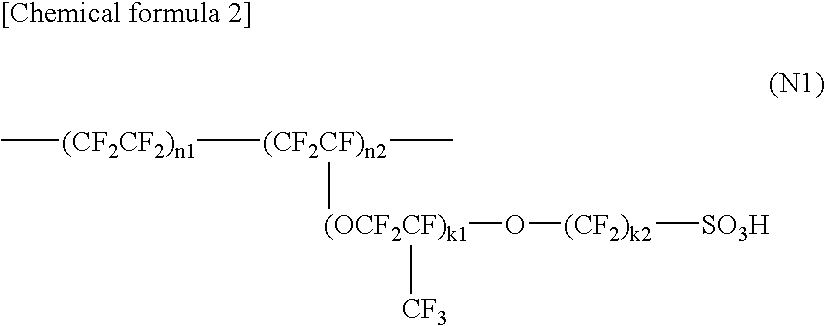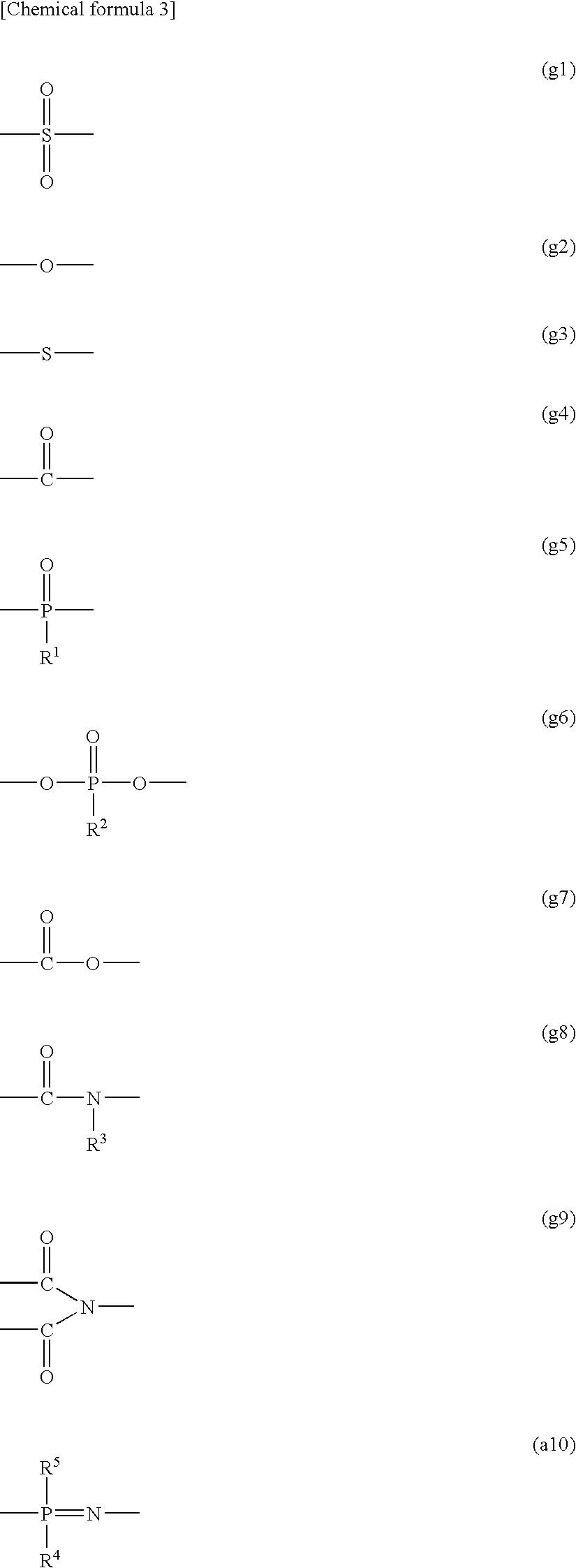Polyelectrolyte Material, Polyelectrolyte Component, Membrane Electrode Composite Body, and Polyelectrolyte Type Fuel Cell
a fuel cell and polyelectrolyte technology, applied in the field of polyelectrolyte materials, polyelectrolyte components, membrane electrode composite bodies, etc., can solve the problems of insufficient fuel crossover, and decrease in cell output and energy capacity, and achieve excellent fuel barrier property and mechanical strength, excellent proton conductivity, and high efficiency
- Summary
- Abstract
- Description
- Claims
- Application Information
AI Technical Summary
Benefits of technology
Problems solved by technology
Method used
Image
Examples
synthesis example 1
Synthesis of Disodium
3,3′-disulfonate-4,4′-difluorobenzophenone (G1)
[0303]
[0304] 109.1 g of 4,4′-difluorobenzophenone was reacted in 150 mL of fuming sulfuric acid (50% SO3) at 100° C. for 10 hours. Then the reaction was put little by little into abundant water, and neutralized with NaOH, to which 200 g of NaCl was added, to make synthesized product precitipate. The resultant precipitate was separated by filtration and recrystallized in ethanol aqueous solution, to give disodium 3,3′-disulfonate-4,4′-difluorobenzophenone shown by the above Formula (G1).
synthesis example 2
Synthesis of Polymer (Sulfonic Acid Group Density 1.7 mmol / g) Shown by Formula (G2)
[0305]
(wherein * represents that the right end of the upper formula and the left end of the lower formula connect each other at that position)
[0306] Using 6.9 g of potassium carbonate, 14.1 g of 4,4′-(9H-fluorene-9-ylidene)bisphenol, 4.4 g of 4,4′-difluorobenzophenone, and 8.4 g of disodium 3,3′-disulfonate-4,4′-difluorobenzophenone obtained in the above Synthesis example 1, polymerization was conducted at 190° C. in N-methylpyrrolidone(NMP). Purification was conducted by reprecipitation in abundant water, and polymer shown by above Formula (G2) was obtained. Sulfonic acid group density after proton substitution of the obtained polymer was 1.7 mmol / g, weight average molecular weight was 220,000.
synthesis example 3
Synthesis of Polymer (Sulfonic Acid Group Density 1.1 mmol / g) Shown by (G2)
[0307] Using 6.9 g of potassium carbonate, 14.1 g of 4,4′-(9H-fluorene-9-ylidene)bisphenol, 6.1 g of 4,4′-difluorobenzophenone, and 5.1 g of disodium 3,3′-disulfonate-4,4′-difluorobenzophenone obtained in the above Synthesis example 1, polymerization was conducted at 190° C. in N-methylpyrrolidone (NMP). Purification was conducted by reprecipitation in abundant water, and polymer shown by above Formula (G2) was obtained. Sulfonic acid group density after proton substitution of the obtained polymer was 1.1 mmol / g, weight average molecular weight was 220,000.
PUM
| Property | Measurement | Unit |
|---|---|---|
| Temperature | aaaaa | aaaaa |
| Temperature | aaaaa | aaaaa |
| Temperature | aaaaa | aaaaa |
Abstract
Description
Claims
Application Information
 Login to View More
Login to View More - R&D
- Intellectual Property
- Life Sciences
- Materials
- Tech Scout
- Unparalleled Data Quality
- Higher Quality Content
- 60% Fewer Hallucinations
Browse by: Latest US Patents, China's latest patents, Technical Efficacy Thesaurus, Application Domain, Technology Topic, Popular Technical Reports.
© 2025 PatSnap. All rights reserved.Legal|Privacy policy|Modern Slavery Act Transparency Statement|Sitemap|About US| Contact US: help@patsnap.com



